-
Posts
719 -
Joined
-
Last visited
-
Days Won
13
Content Type
Profiles
Forums
Events
Store
Downloads
Gallery
Posts posted by GRC
-
-
the two objects at the bottom left are stirrups for riding a horse;

-
 2
2
-
-
Geraint is spot on.
I'd like to add some additional context:
Collectors and dealers have been mixing and matching the components of koshirae from the get-go, to suit their own aesthetic ideals and market trends.
It would be extremely rare to find a blade in all its original mounts.
Add to that, the fact that the samurai themselves had several sets of fittings for each blade, and would swap them out to suit a particular mood or occasion.
So who is to say for sure which set of fittings was the "original" for a specific blade?
Unless of course it was a specially commissioned set of fittings and there's some kind of documentation to back it up.
And btw, that particular tsuba you showed is available is such huge quantities that there is at least one or more available for sale at all times from a variety of sources.
I've now seen so many that I'm starting to think that it could be the most produced cast-iron tsuba pattern in existence...
-
 1
1
-
-
Completely agree with Florian's statement

Here's the one I just missed out on, to someone with deeper pockets...

It's also the example I still had "on the brain", where I thought the Yatsuhashi theme was cleverly and creatively depicted.
I think the raised mimi represents the flower, the zig-zag is the reference to the Yatsuhashi (8 bridges), and the mokume is the water itself.
Stunningly simply and elegant representational art.
I'm already regretting losing out on this one... at least I got to see it and admire it

-
 3
3
-
-
Here's a cast-iron tsuba with a design that your average samurai or merchant might not be able to afford an original of.
But it sure would look nice on a sword (especially without the assistance of "digital zoom" to nitpick at the details).
Back in the day, you'd probably never be close enough to notice it was cast... and if you were, you'd probably be more concerned about losing a limb

(images reposted with permission
 )
)


-
 1
1
-
-
Fantastic!
Congrats on the purchase and making that awesome connection

-
 1
1
-
-
I found some quotes that identify the "target market" for cast-iron tsuba prior to the Meiji period (ie. late Edo period)
I was looking at some more Nanban info and noted that authors associated many of these (but not all) with "SHIIREMONO" (shi-ire-mono).
Here's a previous thread about it on the NMB:
https://www.militaria.co.za/nmb/topic/11499-shiiremono/
Quick summary:
Shiiremono are essentially "mass produced" and generally regarded as lesser quality. However, there was also a full range of quality and prices of shiiremono of all types (not just Nanban-style tsuba).
Lissenden pointed out that bulk production of cast-iron tsuba would certainly fit this type of production. He also noted that the labour intensive "undercutting" openwork of the karakusa-style Nanban tsuba would have benefited greatly from an initial rough casting of the tsuba, followed by hand finishing.
I came across two quotes from reliable sources (Haynes and Gunsaulus) that push the date of shiiremono production back into the Edo period and even as far back as the 1700s.HAYNES quote from SOSHIN in the NMB thread above:
"Here is a definition taken from the glossary of Tsuba An Anesthetic Study by Haynes and Torigoye.
SHIIREMONO: "ready-made article." When applied to tsuba this term refers to ready-made or mass production work of the late Edo age, but may also be applied to mass production pieces of earlier ages. Much SHIIREMONO was made to be sold to foreigners."
GUNSAULUS quote from Japanese Sword Mounts in the Field Museum of Natural History - Chicago
"With the warring epochs definitely closed under the early Tokugawa shoguns, the end of the seventeenth and eighteenth centuries witnessed the culmination of the indulgent and luxurious life of the members of the military class. Tales are told of daimyo who, having lost much of their political power, sought satisfaction in the fields of art and poetry, and who, on account of their leisure worshipped richness and adornment to the extent of painting themselves after the fashion of women and matching their decorated swords with the magnificent costumes which were commonly worn in their court ceremonies. Merchants likewise became more prosperous, and many of them took to wearing swords along with their writing outfits (yatate) thrust through their belts. Due to these developments, the metal-workers outvied one another to produce sword-fittings of extreme beauty and elegance, and likewise, in order to satisfy the demands of the lower classes, artisans, copying the artists, turned out replicas and shiiremono in great number."
So in times of escalating decadence, the lower classes of merchants (who were only allowed to wear one sword) and samurai (who were obligated to wear two swords) would be the target market for less costly copies of some of the finer works being produced for the more affluent.
The quote points out the fact that tsubako were busy outdoing each other to make the next great tsuba, but someone still had to supply tsuba for the masses.
So how does all this relate to cast-iron tsuba?
Although there is no specific mention of "cast-iron" in either of these quotes, they both provide the "need" and the "market" for less expensive, mass produced tsuba in the late Edo period, prior to the Meiji period.
And that fits with the late Edo time frame in Dale's most recent quote of cast-iron tsuba going back to at least the 1840s, as well as some of his other quotes stating that the mass copying of tsuba was well under way before the Meiji period.
-
Coincidentally, here's the same one in better condition, complete with gold highlights (up for auction right now):
Same seem along the mimi.
I also post this one because it has that "waxy-look" to the surface finish that I mentioned earlier.
There are also a bunch of Japanese-style tsuba with different motifs that have this same "look", but are not in the Nanban-style.
I suspect that they could have all been produced by the same source, or at the very least, with the same casting technique.
-
Definitely
 you can see a clear "seem" running along the midline of the mimi.
you can see a clear "seem" running along the midline of the mimi.
And it certainly appears to have enough age to be from sometime in the 1800's.
Again though, Nanban-style tsuba are less reliable sources for this quest, because the country of origin can't always be certain: Japan, China, all over South-East Asia ("Monsoon-Asia"), and the Dutch East India Company was even having them produced as far West as Sri-Lanka.
-
Bob, I must apologize for the earlier post. I should have sent a PM.

I don't want to mar this fantastic thread of "show and tell" you have been entertaining us with for such a long time.
-
Florian, are you thinking it was made sometime in the 1900s?
I could maybe see a 60s psychedelic vibe.
Thanks Curran

I still don't know what to think of this tsuba lol
but it sure is different!
-
"possible" is always a tricky word though...
With regards to an unknown, just about anything is "possible" in the broad sense of the term, but the hard part is turning it into "plausible", with the ultimate goal being "certain".
Without more definitive quotes or documentation to push the date back even earlier, it seems like the idea is still only in the "broadly possible" category.
Some things to consider in pushing the date back even further:
Who would be the target market for these?
And, if you push the date back even further by many decades, then you'd expect to see a LOT more of these older looking cast examples.
You'd also need to show where the necessary cast-iron came from and that it was readily available.
I think that's where that "commercialization of the steel-producing process" statement by Lissenden needs more exploration and clarification.
And, all of this "pushing the date back further" is based on the assumption, albeit a reasonable one, that "if they could do it, they would it".
Just some thoughts to consider...
-
Well now that you mention it Florian, that could certainly be a possibility.
Let me downgrade my "definitely" to a "could be".
I have "Yatsuhashi" on the brain after researching it for the "beams motif" summary.
The Japanese definitely played around with the motif a fair bit so I'm starting to see it everywhere.

-
 1
1
-
-
Dale's right, the dragon is definitely Jakushi school.

Nice start.
Better start building some display shelves for the others you'll buy in the future...
I didn't build enough

-
 1
1
-
 1
1
-
-
It could be the inspiration for "Cousin It" from the Adam's family or maybe Van Gogh's Starry Night?Way ahead of its time for sure




-
 2
2
-
 1
1
-
-
Hi Bob,
hate to say it, but that second one with the Vajra looks like it's cast.
That might also explain the unlisted name.
-
 1
1
-
-
Thanks jean, it would make more sense if he had said "decarburization" both times, rather than alternating with opposing terms.

Probably a typo that both he and his thesis supervisors missed.
But as written, it definitely confuses things.
-
 1
1
-
-
Another one of the Chushu type shown earlier:


-
 2
2
-
-
The anchor tsuba is definitely not Nanban, and it is definitely Japanese.
The "diaper" here is just waves. I believe that what Lissenden was referring to is the "wave-like diaper pattern" found on many (but not all) of the decorated seppa-dai of the Nanban style tsuba.
Here's a few examples:



McElhinney is probably the person who has done the most research into the origins and classification of the different styles and types of Japanese Nanban and Asian Export guards.
He describes Lissenden's Nanban classifications as a "good start" but has added so much more depth and clarification. I see that Mandarin Mansion, as well as Haynes & Long at shibuiswords have been posting quote and articles from him.
Here's a cast Nanban tsuba that just recently sold for 32,600yen in Japan. I have other images that are exact copies of this tsuba pattern so there is no doubt that it is cast iron.
These are copies of tsuba produced by the Yagami school that started in the late 18th century.
This one looks like it has enough patina to be from sometime in the 1800s. But again, we just don't know exactly when, and with Nanban tsuba, we can't always be certain from where (within Japan or from outside Japan). This one is certainly made specifically for the Japanese market, and likely made in Japan.


From Lissenden, "cast-iron" tsuba and iron tsuba that are "moulded" are interchangeable.
Here's his main quote that pushes Japanese iron casting well back into the 1800s:
"However, for many hundreds of years the carburisation of grey cast iron, enabling its conversion into malleable cast iron, (ref 230) had been well known and such a process was described in 1734 by Emanuel Swedenborg as being familiar to Chinese and Japanese metalworkers. (ref 231) While unsuited to the mass production of larger articles because of the amount of time the process demands, decarburisation would have been easily applied to the production of a limited number of smaller articles such as moulded tsuba."
"The moulding of artefacts such as tsuba was thus a readily attainable process long before the popularity of the Namban group of tsuba became established. Conversely, the degree of commercialisation of the iron-producing process by this time leads one to presume that the tsuba makers would have obtained their iron from industrial manufacturers in ingot form. This would probably have already been decarburised commercially by a 'fining' process in order to convert the cast iron into its malleable cast iron form — a form well capable of being wrought into tsuba."
It's this section on page 123 that originally lead me down the path of focusing on malleable cast iron, and trying to sort out the details of when and how this malleable cast iron would have been readily available to tsuba-makers.
I wish he had elaborated on the "commecialisation" aspect of iron production in Japan or had provided some sources for that statement.
-
 1
1
-
-
Hi Grev.
Definitely Yatsuhashi theme

They don't always put 8 bridges.
The flowers aren't always irises.
Both can vary.
But as long as you have water, grasses and/or flowers and zig-zags, it's the Yatsuhashi theme.
The tree trunk is unusual though.
Couldn't hazard a guess as to the exact age, but maybe late Edo as the oldest?
It looks kind of "pristine" though, almost like it was just made. Maybe a presentation piece or gifted tsuba?
-
Well,
On the CAST side of things:
-uniform colour everywhere (which is often some version of a uniform "grey" colour, but sometimes a "waxy-looking" black in some types of the more obvious cast tsuba).
-the mimi and seppa-dai are definitely dimpled with little sand-grain-like craters.
-there are some surface irregularities in the waves on the omote (front) side that has the majority of the anchor on it. And I mean the plate itself, underneath the fine wave lines.
On the HAND-WORKED side of things:
-the inlayed "water droplets".
-there appears to be a few stray chisel marks (or maybe it's just damage?) on the ura (back) side's mimi at the 2 o'clock and 4 o'clock positions.
On the "ambiguous" side of things (for me):
-there appears to be some streaky "flow patterns" around the mimi on both faces of the tsuba, as well as all along the inner, sunken "step" the runs along the inside of the mimi.
*could be indicators of "poured fluid" or indicators of the layers of a "folded plate", but it seems too streaky to be the folded layers. Especially so for the inner, sunken "step" along the mimi.
If that was punched down with a punch, it would be a lot smoother than that, and a chisel would leave different looking marks as well. So, overall it looks more like it was poured fluid.
Overall, I'm leaning towards initially CAST, then hand finished.
I personally don't know if casting can produce such fine ridge lines.
And, just throwing out a guess about the overall process here:
Maybe the tsuba was cast, then inlayed with the water droplets, then the wave ridges were chiseled in by hand afterward?
The timing of when the wave ridges were produced is an unknown for me.
An interesting example Dan

-
 1
1
-
-
Other than being differing opinions, could it also be possible that both attributions are correct?
Motifs were often "shared" or "borrowed" between schools. (No "copyright laws" yet
 )
)
And sometimes a tsubako from one school would move to a new area and join a different school, bringing influences from the previous school with them.
Just throwing those thoughts into the mix...
-
Great advice Grev

Contact the seller (politely) and see how they respond. You might just lose out on the shipping costs.
If they are reputable dealer with lots of stock turnover, maybe you could negotiate for an "in-store credit" to put towards something else in the future? They might be more amenable to that idea if they don't accept the return option.
Sadly, I think just about everyone is going to pick up a cast tsuba or two along the path of the tsuba collecting arc.

Myself included...
-
 3
3
-
-
Bruno, that one's a beauty.

I love the dark vs light Genji-mon on the front and back.
-
By pure accident, I stumbled across two more NBTHK papered examples with "cast-iron" in the title of some past auction listings on Lot-Art. One Echizen and one Shoami.
Here's the screenshots of the titles, the only images available, and the descriptions:

The first one has that "soft, rounded look" to it everywhere.
It's also got "webbing" remnants near the 5 o'clock position, and a weird circular indent deformity at the 3 o'clock position of the mimi: some sort of bubble of gas that formed during casting maybe?
For the second one, I might have initially passed it off as having "surface pitting from corrosion".
But given the title, it would suggest that the "bubbly" indentations on the surface are the result of casting (trapped gases in the mold perhaps?).
If the seller is calling it "cast-iron", then how can I argue with that? I'm sure many of people will recognize the emblem on the image.
And just an added thought: if there's that much pitting on the surface, and it was caused by corrosion, then how are those very thin arcs still intact? They would have likely corroded enough to break clean through at some point.
It is interesting to note however, that the accompanying descriptions in the listings just use the word "iron", when "cast-iron" was used in their titles.
So I can't say with absolute certainty that these were cast, but if it looks like a duck and it's called a duck... then it just might be a duck?
-
 1
1
-


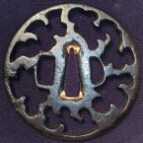
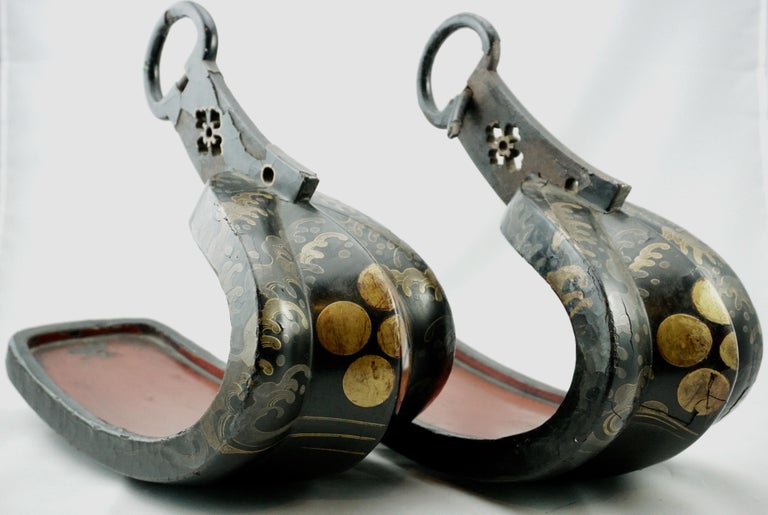


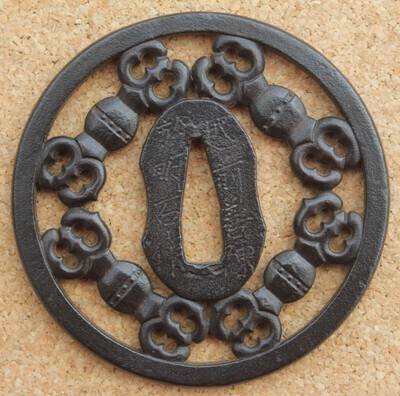
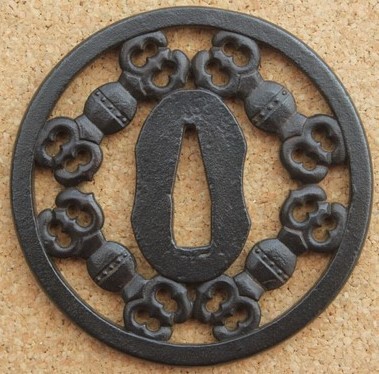
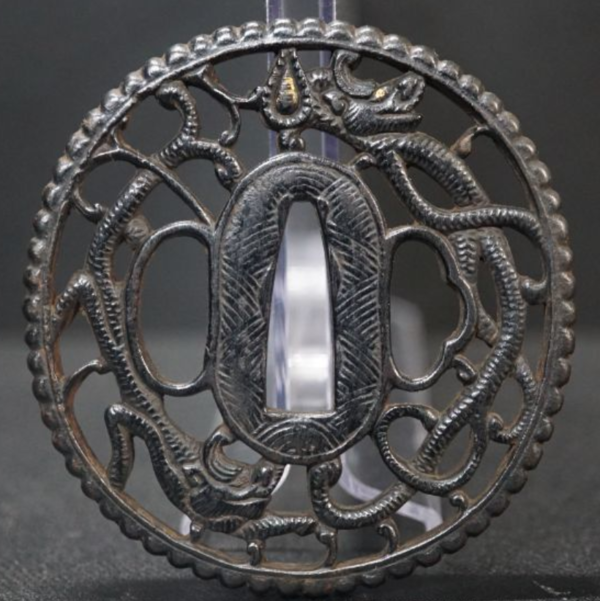

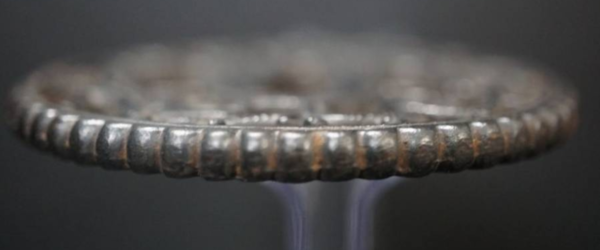




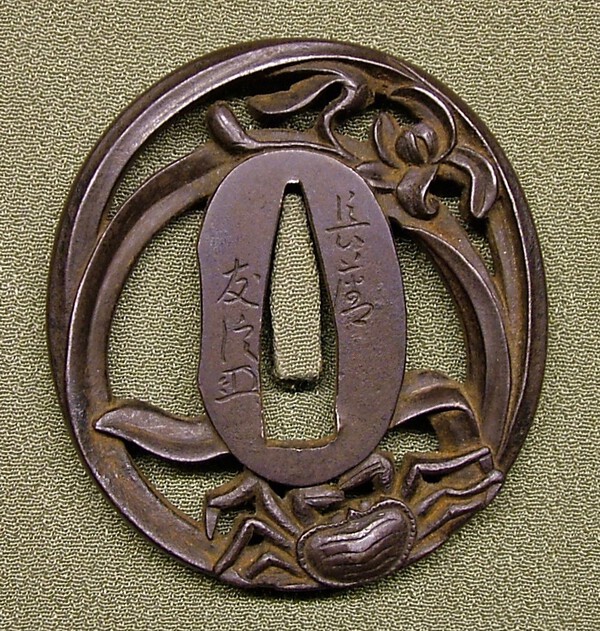


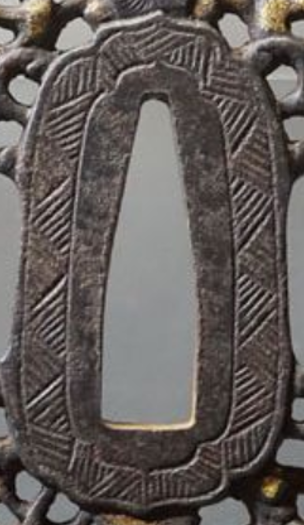








What is represented on this tsuba??
in Tosogu
Posted
That game board also looks like it would serve well as a stepping stool...
So maybe someone was poking fun at a rider who was short in stature and needed a stepping stool and ladder to get up on his horse?
I'm just kidding of course...